Sewing machine quilting stitches are the threads that weave together the artistry, precision, and functionality of quilting.
They are the intricate patterns and stitches that hold the layers of fabric, batting, and backing together, transforming a mere collection of materials into a work of art.
From the foundational running and backstitches to the more elaborate free-motion designs, each quilting stitch serves a distinct purpose, adding texture, dimension, and personality to a quilt.
Whether you’re a quilting novice eager to embark on your creative journey or a seasoned quilter perfecting your craft, understanding the world of sewing machine quilting stitches is essential.
In this exploration, we will delve into the diverse array of stitches and techniques, unlocking the door to a realm of endless possibilities in the quilting universe.
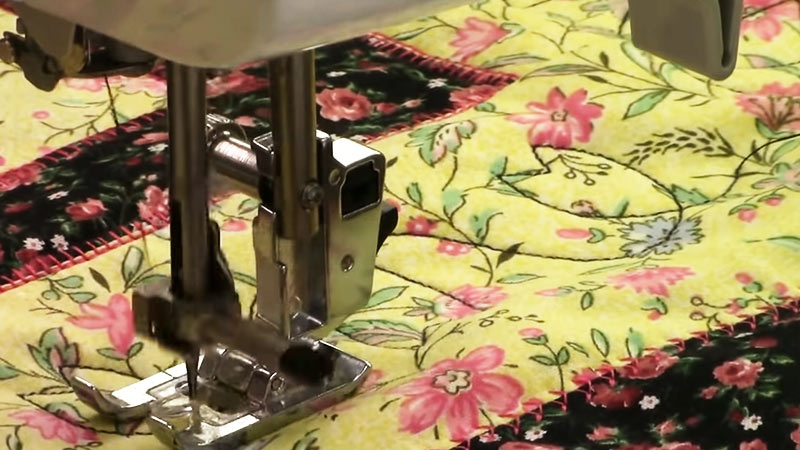
What Are Sewing Machine Quilting Stitches?
Sewing machine quilting stitches refer to the various types of stitches created using a sewing machine to quilt layers of fabric together.
These stitches serve the dual purpose of securing the quilt’s layers and adding decorative elements to the final design.
Characteristics of Sewing Machine Quilting Stitches:
Functionality
Quilting stitches are primarily functional, as they hold the quilt top, batting, and backing fabric together. This ensures the quilt remains durable and can withstand use and washing.
Decorative Elements
Many quilting stitches are chosen for their decorative appeal. They can add texture, dimension, and artistic flair to the quilt, enhancing its visual appeal.
Variety
There is a wide variety of quilting stitches to choose from, ranging from simple straight stitches to intricate free-motion designs. The choice of stitch depends on the desired outcome and the quilter’s skill level.
Precision
Achieving even and consistent stitches is crucial in quilting. Sewing machines allow for precise control over stitch length, width, and tension to create uniform quilting patterns.
Technique
Quilting stitches can be executed using various techniques, including walking foot quilting, free-motion quilting, and stippling, each requiring a different skill set and approach.
Versatility
Quilting stitches can be used in different ways, such as straight-line quilting, stitch-in-the-ditch, echo quilting, and more, allowing quilters to experiment with diverse effects.
Quilting Stitches Patterns
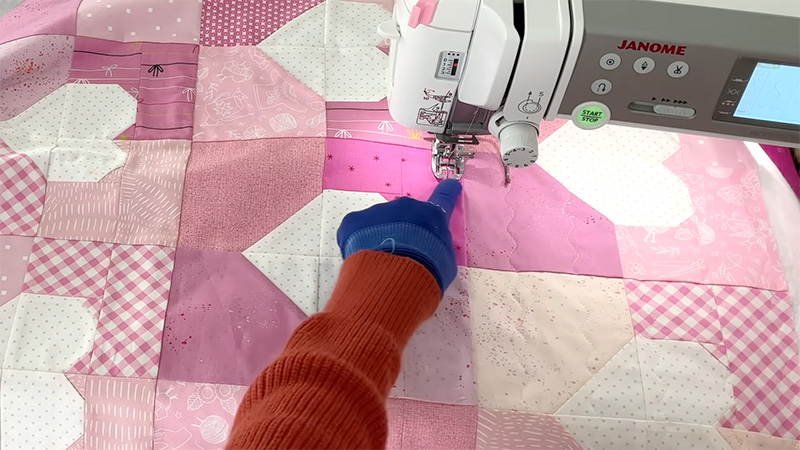
Quilting stitches and patterns are an essential part of the quilting process. They not only hold the layers of a quilt together but also add texture and design to the finished piece.
There are countless quilting stitch patterns to choose from, and the choice often depends on the style and design you want to achieve.
Here are some popular quilting stitch patterns:
Straight Line Quilting
This is the simplest quilting stitch pattern, where you sew straight lines parallel to each other. You can vary the distance between the lines to create different effects.
Stippling or Meandering
Stippling involves creating a continuous, random pattern of curves and loops. It’s great for adding texture to a quilt and is often used for background quilting.
Free-motion Quilting
This technique involves moving the fabric freely under the needle to create intricate, often decorative designs. It allows for a high degree of creativity and can include flowers, feathers, or other motifs.
Echo Quilting
Echo quilting involves quilting lines that parallel and echo the shape of a block or appliqué piece. It can create a lovely dimensional effect.
Crosshatch Quilting
This pattern involves quilting a grid of diagonal lines that intersect. It can be done at different angles and spacings, creating a classic look.
Continuous Curve Quilting
This pattern involves quilting arcs or curves that fit together in a continuous fashion. It’s often used for borders and sashing.
Feather Quilting
Feather quilting mimics the appearance of feathers and is often used in traditional and vintage-style quilts. It requires precision and practice.
Cable Quilting
This pattern resembles twisted or braided ropes and can add a touch of elegance to your quilt.
Grid Quilting
Grid quilting involves quilting straight lines in a crisscross pattern to create a grid. It’s a clean and modern look.
Custom Designs
You can also create your own custom quilting designs to match the theme or style of your quilt. This allows for complete creative freedom.
Types of Quilting Stitches
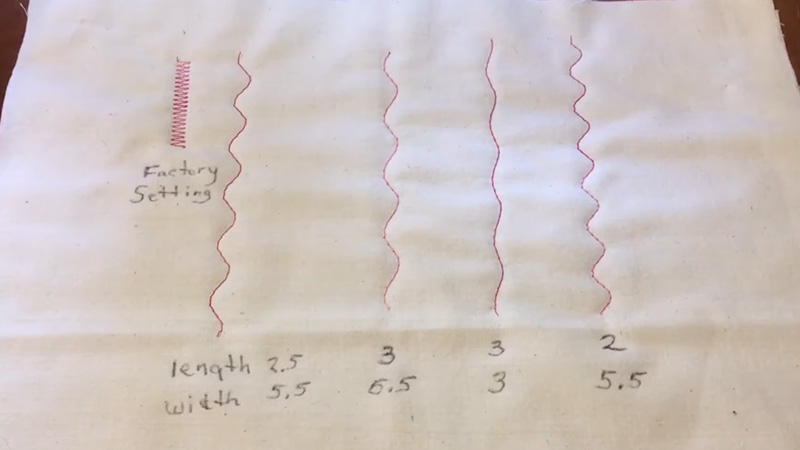
Quilting stitches are essential for securing the layers of a quilt together and adding decorative elements. There are various types of quilting stitches, each with its own purpose and appearance.
Here are some common types of quilting stitches:
Running Stitch
This is a basic and straightforward quilting stitch. It involves sewing straight stitches in even intervals through the quilt layers. It’s often used for utility quilting and can be done by hand or with a sewing machine.
Backstitch
Backstitch is similar to the running stitch but involves sewing a few stitches backward before moving forward. This creates a stronger and more secure stitch. It’s often used for hand quilting.
Basting Stitch
Basting stitches are temporary stitches used to hold the quilt layers together before the final quilting stitches are applied.
They are typically long and loose and are removed once the permanent quilting is completed.
Whipstitch
Whipstitch is a type of hand stitch used for joining the edges of binding or attaching quilt blocks together. It creates a visible, diagonal stitch pattern on the fabric.
Blanket Stitch
This decorative stitch is often used to secure the edges of appliqué pieces. It creates a looped, scalloped edge and can add a decorative touch to your quilt.
Cross-Stitch
Cross-stitch is a type of hand embroidery stitch used for decorative purposes in quilting. It forms X-shaped stitches and is often used for embellishing quilt blocks.
Feather Stitch
Feather stitch is another decorative hand embroidery stitch. It creates a delicate, feathery design and is often used for adding a touch of elegance to quilts.
Free-Motion Quilting Stitch
Free-motion quilting allows you to create various types of stitches, including stippling, meandering, flowers, loops, and more, by moving the fabric freely under the sewing machine’s needle.
Sashiko Stitch
Sashiko is a Japanese quilting technique that involves evenly spaced, straight stitches in a grid or geometric pattern. It is traditionally used for both functional and decorative purposes.
Machine Quilting Stitches
Sewing machines offer various quilting stitch options, including straight stitch, zigzag stitch, serpentine stitch, and more. These stitches can be used for both functional and decorative quilting.
Echo Quilting Stitch
Echo quilting is a technique where you quilt lines that echo the shape of a design or block, creating a dimensional effect. It can be done with both hand and machine quilting.
Continuous Curve Stitch
This quilting stitch involves sewing curved lines that fit together in a continuous pattern. It’s commonly used for borders and sashing.
Do You Backstitch When Machine Quilting?
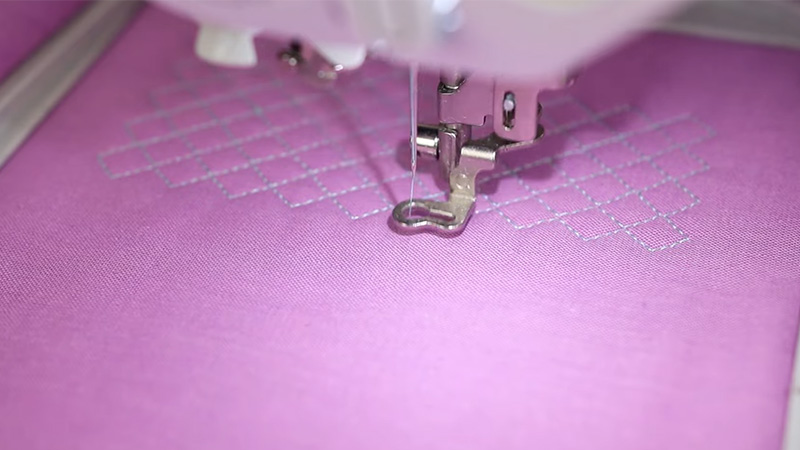
Whether or not you should backstitch when machine quilting depends on the specific quilting technique you are using and your personal preferences.
Backstitching is a technique used to secure the beginning and end of a line of stitches to prevent them from unraveling.
Here’s how it applies to machine quilting:
Straight Line Quilting
When doing straight-line quilting, such as stitching in the ditch or quilting parallel lines, it’s common to backstitch at the beginning and end of each line of stitching. This helps lock the stitches in place and prevents them from coming undone over time.
Free-Motion Quilting
In free-motion quilting, where you move the fabric freely under the machine’s needle to create various designs, you typically don’t backstitch at the beginning and end of a quilting line.
Instead, you often pull the threads to the back of the quilt and tie knots or secure the threads manually after the quilting is complete.
Stippling and Meandering Quilting
When stippling or meandering (creating random curving lines) with a sewing machine, you usually don’t backstitch. Instead, you bring the threads to the back and secure them there.
Continuous Quilting Lines
In some cases, especially when you have a continuous quilting line that will be intersected by another line of quilting, you may not need to backstitch. The intersecting lines of quilting will secure the ends of the previous lines.
Quilting Stitches for Beginners
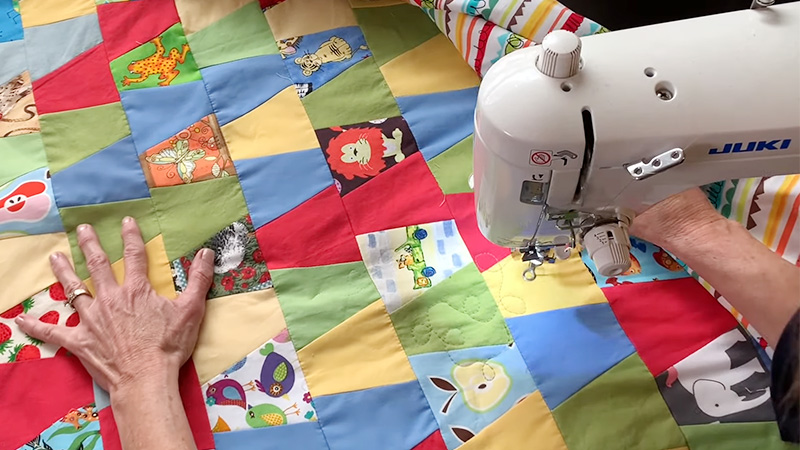
When you’re a beginner in quilting, it’s a good idea to start with some basic quilting stitches and techniques that are relatively easy to learn and can help you build your quilting skills.
Here are some quilting stitches and techniques suitable for beginners:
Running Stitch
The running stitch is one of the most basic and versatile quilting stitches. It involves sewing straight stitches evenly spaced along a quilting line. This stitch is perfect for securing quilt layers and is easy to learn for beginners.
Backstitch
Backstitching is similar to the running stitch but involves sewing a few stitches backward before moving forward. It creates a stronger and more secure seam, making it suitable for hand quilting.
Basting Stitch
Basting stitches are long, loose stitches used to temporarily hold the quilt layers together before you do the final quilting.
They can be hand-stitched or done with a long stitch on your sewing machine. These stitches are meant to be removed once the permanent quilting is complete.
Straight Line Quilting
As a beginner, start with simple straight-line quilting. Sew straight lines parallel to each other across your quilt. This is an excellent way to practice stitching and build your confidence.
Stitch in the Ditch
Stitching in the ditch means quilting along the seams between pieced quilt blocks or pieces of fabric. This technique helps secure the layers together and adds a subtle quilting design without being too challenging.
Echo Quilting
Echo quilting involves quilting lines that echo the shape of a design or block. It’s a forgiving technique that doesn’t require perfect precision, making it suitable for beginners.
Meandering or Stippling
Meandering or stippling is a random, curving quilting design that can be forgiving for beginners. It’s a great way to add texture to your quilt without the need for precise stitching.
Free-Motion Quilting
While free-motion quilting can be challenging for beginners, it’s a valuable skill to learn. With practice, you can create intricate designs by moving the fabric freely under the machine’s needle.
Start with simple designs like loops or swirls and work your way up to more complex patterns.
Cross-Hatch Quilting
Cross-hatch quilting involves sewing diagonal lines that intersect to create a grid pattern. It’s a straightforward design that adds a classic touch to your quilt.
Use Quilting Rulers
Quilting rulers and templates can help beginners achieve straight lines and geometric shapes in their quilting. They provide guidance and help maintain even spacing.
FAQS
Can I use different thread weights for quilting stitches?
Yes, you can use various thread weights for quilting. Thicker threads create a more pronounced texture, while finer threads offer a subtle look.
What is the purpose of a walking foot in quilting?
A walking foot, also known as an even-feed foot, helps prevent fabric layers from shifting during quilting.
Do I need a special quilting needle for machine quilting stitches?
Using a quilting or a sharp needle designed for machine quilting can make a significant difference in your quilting experience.
Can I use different stitch lengths and widths for quilting on my sewing machine?
Yes, most sewing machines offer adjustable stitch length and width settings.
Last Words
Sewing machine quilting stitches are a diverse set of techniques that play a pivotal role in the art of quilting.
From the fundamental running stitch to the intricate designs achievable through free-motion quilting, these stitches allow quilters to secure layers of fabric, add texture, and infuse artistic flair into their creations.
Whether you’re a novice just starting or an experienced quilter honing your skills, understanding and mastering these stitches opens up a world of creative possibilities.
As you explore the various quilting stitches and techniques, you’ll find your unique style emerging, creating quilts that are not only functional but also beautiful works of art.
Leave a Reply